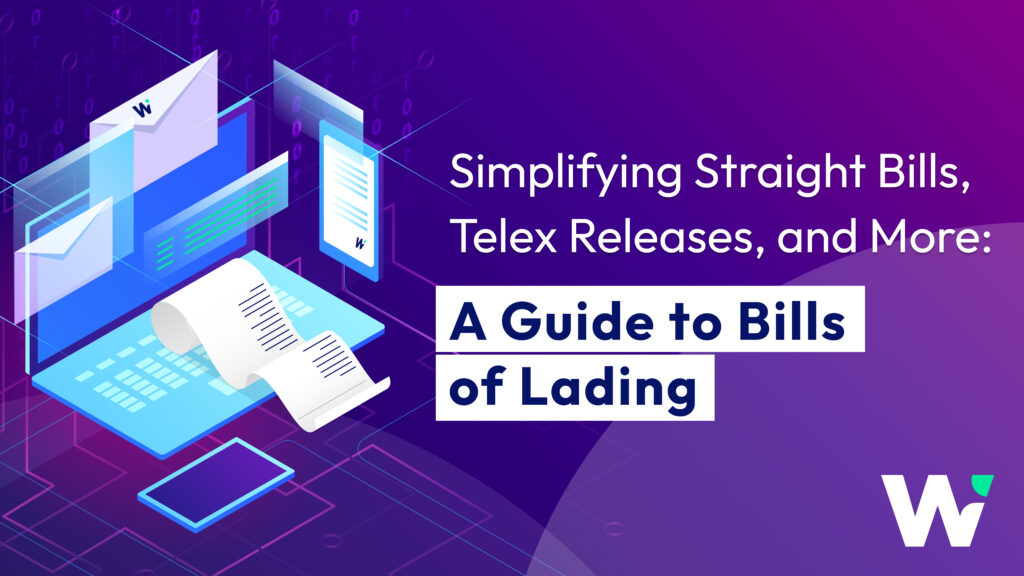Every shipment relies on precision and speed—but outdated, manual processes for managing critical documents introduce unnecessary delays, errors, and risks. With over 90% of global goods moving by ocean, there’s no room for inefficiencies.
According to a recent DCSA report, 49% of cargo owners encounter time-consuming booking processes, while 43% report fragmented communication, leading to costly demurrage and storage fees.
But it doesn’t have to be this way.
In this post, we’ll explain the key types of Bills of Lading and show you how WaveBL’s digital solutions are transforming the way businesses manage Bills of Lading—enhancing visibility, reducing errors, and saving time.
Master Bill of Lading (MBL) vs. House Bill of Lading (HBL)
Every shipment requires a Master Bill of Lading (MBL)—the carrier’s formal record of the cargo’s journey. House Bills of Lading (HBL), however, are only issued when freight forwarders are involved, adding flexibility for smaller, consolidated shipments.
Master Bill of Lading (MBL)
The MBL serves as the primary contract between the shipper and the ocean carrier, detailing the cargo’s route, ownership, and delivery terms. It guarantees that goods reach their destination and acts as legal proof of shipment.
House Bill of Lading (HBL)
An HBL is issued by a freight forwarder or NVOCC to manage part of the shipment, often used for consolidated cargo. It provides additional control and visibility for the forwarder but isn’t required for every shipment, they’re primarily used for groupage or smaller cargo that involves multiple clients.
By leveraging WaveBL’s digital solutions, the management of both MBLs and HBLs becomes streamlined, secure, and visible—giving businesses greater control over their operations.
Choosing the Right Bill of Lading Type
Once you’ve got your MBL or HBL, the next step is to determine what type of Bill of Lading you need—either Straight, Order, or Bearer.
- Straight Bill of Lading (Non-Negotiable): This document is issued to a specific consignee, meaning only that party can claim the goods. There’s no possibility of transferring ownership mid-shipment, making it a great option when the cargo is destined for a single recipient.
- Order Bill of Lading (Negotiable): If flexibility is what you need, the Order B/L allows ownership to change hands mid-shipment. The cargo can only be released once the holder endorses the bill, adding an extra layer of security to the transaction.
- Bearer Bill of Lading: The goods can be claimed by whoever physically holds the document. While this provides the highest degree of flexibility, it comes with increased risk since possession equals ownership. It’s rarely used due to modern security concerns but can still be effective for specific types of transactions.
These B/Ls are essential to securing ownership of the cargo and ensuring the proper transfer of goods during transit.
Sea Waybills and Telex Releases: Quick Solutions, but at a Cost
Sometimes, Sea Waybills and Telex Releases are used alongside Bills of Lading to simplify or speed up shipping processes. While they can offer faster solutions, both come with significant drawbacks that introduce risks and limitations.
Sea Waybill
A Sea Waybill allows for quick cargo release without requiring the original document for pickup. However, it removes the ability to transfer ownership mid-shipment, limiting flexibility. Sea Waybills work best for straightforward shipments—such as those between a company’s own branches—where the sender and receiver have a pre-existing relationship built on trust.
While they reduce the need for paperwork, Sea Waybills aren’t ideal for more complex transactions involving ownership changes during transit.
Telex Release
Initially introduced as a quicker way to release cargo without presenting the original Bill of Lading, Telex Releases now rely on emails or faxes, both of which are prone to miscommunication, errors, and even fraud. The DCSA report highlights that 53% of cargo owners experience delays in processing B/Ls, and 50% face challenges with amendments—issues that are often compounded by Telex Releases.
Both documents can streamline the release process, but they come with notable security risks and limitations. More importantly, they don’t offer the legal protection of traditional Bills of Lading, which must be used in conjunction with them.
Digitizing Bills of Lading: The WaveBL Solution
By digitizing trade documentation, WaveBL eliminates inefficiencies and bottlenecks. Manual processes—still used in 40% of shipping activities—are replaced with automation, reducing errors and delays.
Here’s how WaveBL transforms documentation:
- Turn Documents into Live Data: Extract key insights from uploaded documents, streamlining workflows.
- Automated Document Generation: Create shipping instructions with minimal manual input.
- Real-Time Data Sharing: Eliminate email delays and communicate instantly.
- Seamless Integration: Sync WaveBL with your systems through APIs for real-time tracking.
- Blockchain Security: Keep documents tamper-proof and verifiable.
Whether it’s MBLs, HBLs, Sea Waybills, or Telex Releases, WaveBL ensures your operations are faster, more secure, and compliant.
eBL Success Stories: Simplifying and Accelerating Documentation with WaveBL
Leading companies are already transforming their Bill of Lading management by adopting WaveBL’s digital solutions, replacing manual processes with secure, streamlined operations:
- KPM: “Using WaveBL saved 2.5 hours per BL, with documents arriving five days before cargo—no more courier delays.”
- All-ways Forwarding: “WaveBL allowed us to transfer eBLs in minutes instead of days, ensuring instant, authenticated transfers.”
- RS Logistics: “Our efficiency jumped by 70% after shifting to a single platform for managing trade documents.”
- Hecny Group: “We improved efficiency by 33% with fewer steps, speeding up the entire process.”
- Savino Del Bene: “Real-time access to digital documents reduced errors, delays, and boosted operational visibility.”
By digitizing Bills of Lading with WaveBL, these companies have cut delays, improved efficiency, and eliminated manual errors, ensuring seamless, secure trade operations.
Join the Digital Revolution: Work Smarter with WaveBL
It’s clear: the future of trade documentation is digital. Whether you’re dealing with Master Bills, House Bills, Sea Waybills, or Telex Releases, WaveBL simplifies the entire process, reducing costs, saving time, and improving security.
Are you ready to transform your shipping documentation? Start your journey with WaveBL today and experience the future of global trade.



